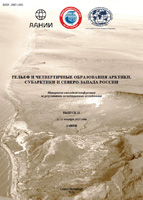| ||
|
| ||
|
doi: 10.24412/2687-1092-2024-11-400-407 1VNIIOkeangeologia, St. Petersburg, Russia 2St.Petersburg State University, St. Petersburg, Russia
|
|
Abstract. The analysis of paleomagnetic characteristics of bottom sediments from the northern part of the Barents Sea sampled during the 2023 expedition allowed us to presumably trace the interval with the Gothenburg excursion (13,000-12,000 years ago) and identify a marking layer with anomalous values of paleomagnetic parameters. The anisotropy of magnetic susceptibility data serves as an indicator of the magnetic texture of sediments, which provide information on the hydrodynamics of sedimentation. The complex analysis of magnetic susceptibility curves and grain size distribution traces the wedging of the layer from the deeper part of the section to the Perseus Bank. As a result, the measurements obtained provide additional information not only for stratigraphic dissection and correlation of Upper Quaternary deposits, but also for studying the dynamics of the geomagnetic field and climate. Keywords: bottom sediments, paleomagnetic studies, excursions, magnetic susceptibility, anisotropy, Barents Sea
REFERENCES: Guskova E.G., Raspopov O.M., Piskarev A.L. et al., Geomagnetic Field Fine Structure for the Last 30 kyr Based on the Magnetization of the Barents Sea Sediments // Geomagn. Aeron. 2004. Vol. 44. Is. 4. P. 510–516. Guskova E.G., Raspopov O.M., Piskarev A.L. et al. Manifestation of the Gothenburg geomagnetic field excursion in the Barents Sea bottom sediments // Geomagn. Aeron. 2007. Vol. 47. P. 781–786. Gusev E.A., Yarzhembovsky Ya.D., Elkina D.V., Ponimaskin P.I., Krylov A.V., Zykov E.A., Lodochnikova A.S., Kartashev A.O., Golosnoy A.S., Zakharov V.Yu., Brui E.V. Structure of the Perseus Rise eastern slopes (Barents Sea) // Relief and Quaternary deposits of the Arctic, Subarctic and North-West Russia. 2023. Issue 10. P. 67-77. doi: 10.24412/2687-1092-2023-10-67-77 Kochegura V. V., Application of Paleomagnetic Methods during the Geological Survey of the Shelf. VSEGEI, St. Petersburg, 1992. 143 p. Musatov E.E. Distribution of the Cenozoic Cover on the Barents Sea Shelf between Svalbard and Franz-Josef Land Archipelagos // Oceanology. 1996. Vol. 36. № 3. P. 444-450. Pisarev S.V. Review of the Barents Sea hydrological conditions. In The Barents Sea System; Lisitzin, A.P., Ed.; GEOS: Moscow, Russia, 2021; pp. 153−166. (In Russian). doi: 10.29006/978-5-6045110-0-8/(13) Piskarev, A.L., Guskova, E.G. Primenenie paleomagnitnyh metodov pri izuchenii donnyh osadkov morej i okeanov. Materialy otcheta. St. Petersburg, 2010.
Elkina D.V., Gostenina А.А.,
Piskarev A.L., Gusev Е.A.
First results of paleomagnetic studies on sediment
cores from the Eastern Arctic seas // Relief and Quaternary deposits
of the Arctic, Subarctic and North-West Russia. Kirschvink J.L. The least-squares line and plane and the analysis of palaeomagnetic data // Geophysical Journal International. 1980. Vol. 62. Is. 3. P. 699–718. doi: 10.1111/j.1365-246X.1980.tb02601.x Tarling D.H., Hrouda F. The magnetic anisotropy of rocks. Chapman and Hall, London, 1993. 217 pp.
|
|
Cite this article: Khosnullina T.I., Elkina D.V., Piskarev A.L., Gusev E.A. Disstribution of upper quaternary sediments of the northern part of the Barents sea using magnetic and paleomagnetic parameters // Relief and Quaternary deposits of the Arctic, Subarctic and North-West Russia. 2024. Issue 11. P. 400-407. doi: 10.24412/2687-1092-2024-11-400-407
|

